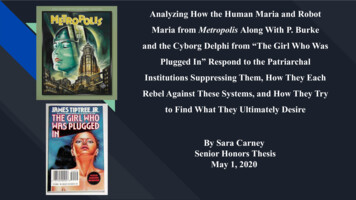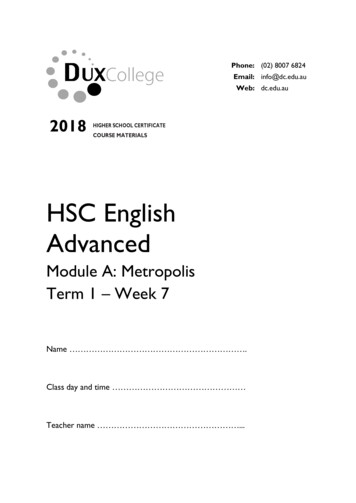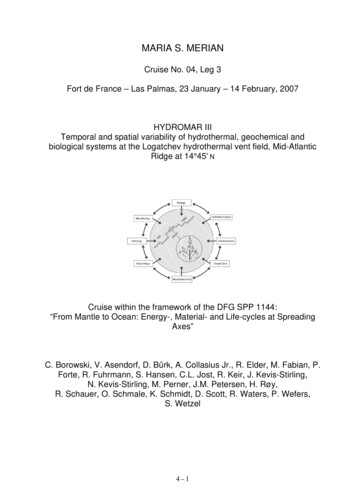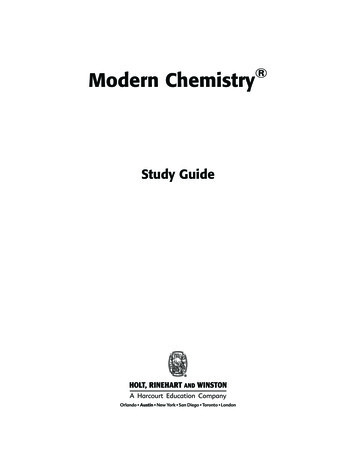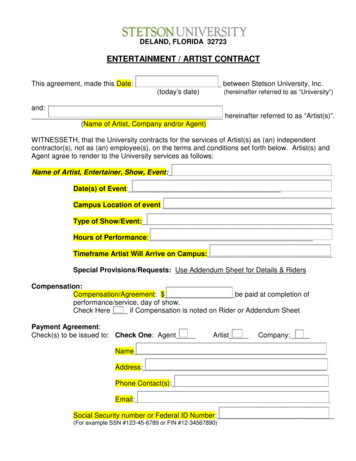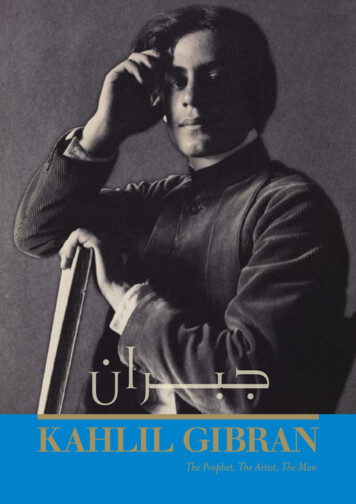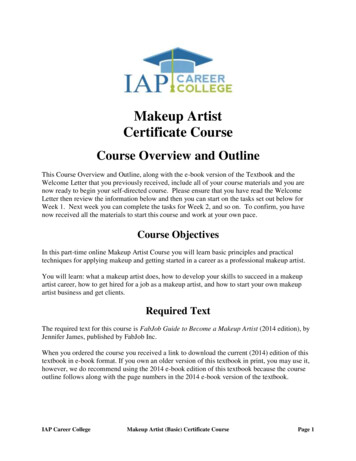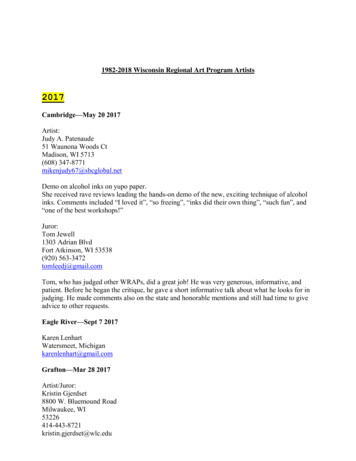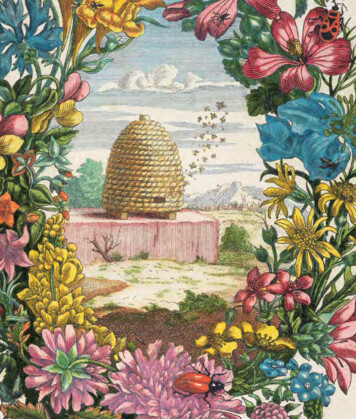
Transcription
titleMaria Sibylla MerianA RT I S T S CI E NT I S T A DVE NT U RE RSarah B. Pomeroyand Jeyaraney KathirithambyThe J. Paul Getty Museum Los AngelesMARIA SIBYLLA MERIANMARIA SIBYLLA MERIAN32
ContentsTo my grandchildren, Nate, Joel, Jesse,Introduction 7Talia, Simone, Dina, and Jacob; toChapter One: Growing Up with Art and Nature11Chapter Two: Painter, Scientist, Wife, Mother23Chapter Three: Transforming Her Life37Chapter Four: Danger, Discovery, Adventure51Chapter Five: Sharing the Wonder71the memory of Alexandra Pomeroy;and to the memory of Elicia Brown Pomeroy sbpTo Jacob ArunEpilogue 83 jkGlossary 89Acknowledgments91Selected Bibliography92Index 94Lobster Claw with Potter Wasp andSouthern Army Worm from The Insectsof Surinam by Maria Sibylla Merian
7MARIA SIBYLLA MERIAN6—Introduction“All this inspired me to undertake a longand costly journey, and to sail to Surinam in America.” Maria Sibylla MerianIt was a dangerous voyage—two months crossing the Atlantic Ocean in a wooden boat about thelength of two school buses. Storms rocked the seas,and pirates plied the waters looking for ships carrying valuable cargo. Friends begged Maria SibyllaMerian not to go, but she refused to listen to them.She had made up her mind.In June 1699 Maria Sibylla and her daughterDorothea sailed from Holland to Surinam, in SouthAmerica, to explore the jungles in search of exoticcreatures no European had ever seen. They were thefirst people to journey to the Americas for purely scientific reasons, and they planned to study and paintpictures of every new animal and insect they found.Maria Sibylla Merian was one of the earliestentomologists—scientists who study insects—andalso one of the world’s first ecologists—scientistswho study the relationships among living things inthe environment. At the age of thirteen she began animportant study of metamorphosis, the process by
1719 edition of The Insects of Surinam by MariaSibylla Merian, now in the collection of the GettyResearch Institute in Los Angeles, CaliforniaCoral Bean Tree with Giant Silkworm fromThe Insects of Surinam by Maria Sibylla MerianMARIA SIBYLLA MERIANwhich caterpillars change into moths and butterflies. She investigated the development of tadpoles into frogs and was the first to describe army ants, orb weaverspiders, and many other rain-forest creatures. She understood how living thingsinteracted and was the first to draw a complex ecosystem on a single page. Morethan a dozen species of insects, animals, and plants have been named in her honor.Not only a scientist, Maria Sibylla Merian was also a famous artist. She had atalent for making accurate illustrations of plants and animals that were also verybeautiful. She pictured insects among the flowers and fruits they liked to eat, andshe did so in artistic ways that were wonderful to see. Today, paintings, drawings,and hand-colored books by Maria Sibylla Merian can be found in museums and artcollections all over the world.Artist, scientist, adventurer: Maria Sibylla Merian, born in 1647, more than 350years ago, was a woman far ahead of her time.CaptionMARIA SIBYLLA MERIAN98
MARIA SIBYLLA MERIAN1110Chapter oneGrowing Up with Art and Nature“This inspired me to collect all thecaterpillars I could find and to observetheir metamorphoses.” Maria Sibylla MerianIris with Dot Moth from The Caterpillar Bookby Maria Sibylla MerianStories of faraway places, paintings of flowers, and a family of artists surroundedMaria Sibylla Merian as she grew up. Her extended family was huge, including half brothers, half sisters, and stepsisters, and her home in Frankfurt,Germany, was always filled with people. The painting studio was her favoriteroom in the house, cluttered with brushes, easels, dried flowers, and paintsin many colors. It was a busy place, where students and apprentices came tostudy with her stepfather, Jacob Marrel. Jacob was a well-known painter of flowerswoven into wreaths or arranged in vases. This type of painting is called still life,because it shows objects captured in a moment, as if frozen in time. As long as shedidn’t get in the way, young Maria Sibylla was allowed in the studio. She watched theartists at work and helped by cleaning brushes and mixing paints.When Jacob realized that Maria Sibylla was good at drawing, he began to includeher in the lessons he gave to his students. She learned to paint in her own home,which was lucky, because girls were not allowed to attend art school. And unlikeJacob’s male students, Maria Sibylla could not become an apprentice in anotherartist’s studio. But she could still hope to become a professional artist someday, andshe learned all she could from her artistic family.Maria Sibylla’s father, Matthäus Merian the Elder, had been an artist and publisher. He had children from his first marriage before he married Maria Sibylla’smother, Johanna Sibylla Heim. Maria Sibylla’s father died when she was only threeyears old. Her mother later married Jacob Marrel, who also had children fromhis first marriage. Maria Sibylla learned about art from her stepfather, her half
MARIA SIBYLLA MERIANRoman Denarius with Sibylla, mint of Rome, 65 BCEMaria’s middle name, Sibylla, is derived from the name of anancient Roman prophet, Sibyl of Cumae, who was said to tellthe future. She is depicted on this Roman coin made abouttwo thousand years ago. Roman history and mythology werepopular in Europe during the seventeenth century.View of Frankfurt in a Floral Wreath by Jacob Marrel, 1650–51Maria Sibylla’s stepfather, Jacob Marrel, was a well-known artist, and hepainted this wreath of flowers. In the center he shows a miniature view ofthe city where the family lived, along the Main River in Germany.Oil Painting Studio printed by TheodorGalle, about 1580, after a design by Jan vander StraetArtists’ studios were busy places. In thispicture the master artist is standing ona platform painting a large canvas, whileapprentices and assistants work all aroundhim. On the left, one paints the portrait of alive model who sits in a chair nearby. Twoapprentices are sketching. In the center,a young man is mixing colors, while in thebackground, on the right, two others aregrinding pigments and mixing them with oilto make paint.Floral Wreath with Lilies, Anemones, Peonies, and a Sunflower fromThe Caterpillar Book by Maria Sibylla MerianMaria Sibylla learned to paint from her stepfather, and when she wasgrown-up, she often painted wreaths of flowers like the ones her stepfather made in his art studio.Portrait of the Family of Matthäus Merian theElder by Matthäus Merian the Younger, 1642This is a portrait of Maria Sibylla’s father, the artistMatthäus Merian the Elder, surrounded by his firstwife and their children. The painting shows thatMaria Sibylla was born into a large family, includinghalf siblings who were much older than she was.The figure on the left is Matthäus Merian theYounger, who was also an artist and points himselfout as the one who painted this picture. Some ofthe family members are dressed up like ancientRomans, whom they admired. The child on the rightis holding a plaster cast of the head of an enormousRoman statue. Artists used these casts as models fortheir paintings.brothers, and the many artists who visited or worked in Jacob’s studio. Besidesdrawing, painting, and engraving, she learned to see like an artist, to develop herskills at observation, and to think like artists do about the world around them.Like most artists of her time, Maria Sibylla probably began by copying drawingsand paintings made by others. Since her stepfather’s workshop specialized in flowerpaintings, she may have started with small sketches of individual flowers beforeshe tried putting them together in larger compositions. Some of her later paintingsfeature single flowers, and some are like Jacob’s, with vases filled with many flowersthat would have bloomed at different times of the year.Jacob painted his flowers with watercolors on vellum—a sheet of animal skin,scraped thin, soaked in lime, and stretched and dried. Vellum was expensive, andnot a bit was wasted. In the studio Maria Sibylla learned how to prepare vellum witha thin coating of opaque white material that created a bright, smooth base for thewatercolor paints that had been so carefully prepared.Yellow for daffodils, pink for carnations, blue for irises . . . these colors did notcome in trays or tubes as they do today. Artists like Maria Sibylla had to make theirown paints using natural materials, including minerals, plants, and even shellfishand insects. These were ground into powders called pigments. Many came fromMARIA SIBYLLA MERIAN1312
MARIA SIBYLLA MERIANVase with Flowers by Jacob Marrel, 1635Cochineal, Lapis Lazuli, and Gum ArabicMaria Sibylla’s stepfather painted this arrangement offlowers. There are insects and animals in the paintingtoo, but they lack detail and seem out of place on top of awooden table.These are some of the natural materials MariaSibylla used to make paints.Spring Flowers in a Chinese Vase from The New Bookof Flowers by Maria Sibylla MerianMaria Sibylla painted this still life. She included thestag beetle to “enliven” the painting, which was mainlyfocused on the flowers. In her later work, Maria Sibyllashowed insects in their natural environments.Study Book by Maria Sibylla MerianWhen she was thirteen, Maria Sibylla began torecord her observations about caterpillars andbutterflies, and she painted pictures of them infull color. She later copied her notes into a studybook she would keep nearly all her life. It eventually included 318 studies of different insects andhundreds of drawings of eggs, pupae, caterpillars,beetles, butterflies, moths, and other creatures. Shewrote in German using black letter, or Gothic script,common throughout Europe in the seventeenthcentury but today read only by scholars.Self-Portrait by Jacob Marrel, 1635After the death of Maria Sibylla’sfather, her mother married theartist Jacob Marrel. In thisself-portrait he shows himselfat the age of twenty-one,painting one of the floralstill lifes for which he wasbest known.faraway lands: orange-red cinnabar from Spain, blue lapis lazuli stone from Afghanistan. Carmine red came all the way from South America, where it was made fromcochineal insects that live only on a particular type of cactus. To use these pigments,Maria Sibylla first had to mix them with a binder, something that made them stickto the vellum. Oils were used for oil paints, but to make watercolors, Maria Sibyllamixed the pigments with water and gum arabic, a sticky substance collected fromthe bark of acacia trees. It wasn’t easy to get just the right mix of pigments to matchthe exact color of a particular flower, or to get just the right amount of binder tomake the color easy to paint with and to dry—but not too fast. Maria Sibylla learnedby doing.There were not just flowers but also insects in some of Jacob’s paintings, and inthe studio there were dead, dried specimens stuck on pins for the artists to use asmodels. As Maria Sibylla later recalled, “I was always encouraged to embellish myflower painting with caterpillars, summer birds [butterflies] and such little animalsin the same manner in which landscape painters do in pictures, to enliven the onethrough the other, so to speak.” But Maria Sibylla didn’t want to use dead bugs asmodels; she wanted to paint insects while they were alive, to capture their true colorsand show how they behaved in their natural environments. She was curious abouttheir lives—where they came from and how they grew. She especially loved to watchwiggling silkworms and the changes they went through from egg to larva to cocoon tomoth. “Then I noticed that much more beautiful butterflies and moths emerged fromother caterpillars,” she wrote. “This inspired me to collect all the caterpillars I couldfind and to observe their metamorphoses.” Metamorphosis is a Greek word meaning“transformation.” The word could apply to Maria Sibylla herself, as she went throughmany changes during the course of her adventurous life.The first transformation took place at age thirteen, when she made a surprisingdecision. “I set aside my social life. I devoted all my time to these observations [ofinsects] and to improving my abilities in the art of painting, so that I could both drawindividual specimens and paint them as they were in nature. I collected all the insectsI could find around Frankfurt . . . and painted them very precisely on vellum.”MARIA SIBYLLA MERIAN1514
1716Metamorphosis of the SilkwormMaria Sibylla’s first illustration in her first scientific book was the life cycle of the silkworm,which she based on the earliest observationsin her study book. The life cycle begins withthe eggs (lower right corner), which hatch intocaterpillars (technically called larvae) after tendays. The bodies of caterpillars are segmentedand often covered with hairs. As a caterpillareats, it grows and periodically sheds its outerskin—which is actually an external skeletoncalled a cuticle—in a process called molting.The Reeling of Silk printed by Karel van Mallery,about 1595, after a design by Jan van der StraetSilk manufacture was women’s work. In this engravingthe woman holding a child is supervising the workshop.The women pictured in the background are gatheringcocoons to be brought indoors. Inside, other womenunwind the silk fibers from the cocoons and wind themonto reels so that they can be spun into thread.Maria Sibylla wrote, “The size of the larvaeincreases every day, especially when theyhave enough food. They reach their full size inseveral weeks to two months. The larvae shedtheir skins completely three or four times, justas a person pulls off a shirt over his head.” Thesilkworm caterpillar sheds its cuticle five times.The large caterpillar in the lower middle of thepicture is sitting on a mulberry leaf, and it is inthe process of shedding its wrinkled cuticle. AWreath of White Mulberry with SilkwormMetamorphosis from The Caterpillar Book byMaria Sibylla MerianOn this decorative page Maria Sibylla depictedthe silkworm in different stages of developmenton a wreath made with its favorite food—mulberryleaves.Maria Sibylla collected caterpillars and insects from gardens within walkingdistance of her home. She found specimens in trees along the river and took rides ina horse-drawn carriage to the countryside just beyond the city. To her mother’s dismay, she began raising caterpillars at home, keeping them alive in wooden boxes andgiving them lettuce leaves to eat. She watched each one change from a caterpillar to amoth or butterfly. Like a modern scientist, she took notes, recording her observationswith words, drawings, and paintings. Careful note-taking was a habit she would keepthroughout her life.She continued to study silkworms, which she considered “the most useful andnoble of all worms and caterpillars” because the fibers of their cocoons could bemade into silk cloth. She would not have found silkworms outside but at a silk manufacturer’s workshop. The ancient Chinese had been the first to spin silk threadfrom the fibers of the silkworm cocoon, and the fabrics they wove were the envy ofthe world. The women of ancient Rome loved silks for their lightness and theway they absorbed colorful dyes. But for a long time no one knew how to make silkoutside of China, and the Chinese emperors threatened death to anyone who wouldcuticle that has already been shed is to the leftof the mulberry leaf.In the next stage of metamorphosis, thecaterpillar uses its silk glands to produce afluid that it forces through its mouth. This fluidhardens in the air to create the silk thread that itwraps or spins around its body to form a protective cocoon. Inside the cocoon, the caterpillarchanges into a pupa. Maria Sibylla shows ayellow cocoon in the middle of the painting. Justabove it is a cocoon showing the pupa inside,Metamorphosis of the Silkworm from The Caterpillar Book by Maria Sibylla Merianand a whole pupa is visible on the far right.While the insect is a pupa, chemical reactionscause many of the larval tissues to break down,adult moth emerges, leaving the cocoon empty.At the top are two adult moths. The male onwithout a magnifying glass, and some peopledidn’t know they existed, thinking that worms,and the pupa fills with what appears to be athe left is secreting semen. The female, which iscaterpillars, and flies simply emerged fromwhite, milky sap. Then flat, round sheets of cellsmuch bigger, is laying eggs. Maria Sibylla showedrotten food or dirt. Maria Sibylla’s careful obser-called imaginal discs begin to form structuresthe reproductive process because it was thevation of insect reproduction and her detailedsuch as adult wings, legs, and antennae. Thisleast understood part of the insect life cycle atdiagram of metamorphosis helped to disproveprocess takes five to seven days. Finally thethat time. Insect eggs are tiny and hard to seethese mistaken beliefs.
MARIA SIBYLLA MERIANreveal the secret. Eventually travelers smuggled silkworms out of China, and Europeans began cultivating them, together with the mulberry trees on which they fed.By Maria Sibylla’s day, silk was made in Frankfurt in family workshops not unlikethe Marrel art studio.But Maria Sibylla wasn’t interested in silkworms just for their cocoons. Shewas fascinated by the changes that occurred throughout their life cycle. Shedescribed their appearance and behavior in her notes and drew pictures of theeggs that developed into caterpillars that spun cocoons, out of which flew mothsthat laid eggs that developed into caterpillars . . . it was all amazing to her. She wrote,“The metamorphosis of caterpillars has happened so many times one is full of praiseat God’s mysterious powers and the wonderful attention he pays to such insignificantlittle creatures.”Still, why would Maria Sibylla go to such trouble to observe metamorphosis firsthand, instead of reading about it in a book? Why would she want to collect worms shehad to feed every day, whose boxes she had to keep clean? Because at the time, no bookexisted that explained insect metamorphosis correctly. Some people still believed inAristotle’s theory of “spontaneous generation,” which held that living things couldspring from nonliving matter. They didn’t know that all insects laid eggs and thoughtsome just “spontaneously” grew out of mud and garbage. It would take collecting theinsects, raising them to adulthood, and observing their reproduction to begin to comprehend the whole process of metamorphosis. And that is exactly what Maria Sibyllastarted doing when she was thirteen years old.This piece of embroidery is typical of those made bygirls and women in seventeenth-century Germany.Called a sampler, it was used for trying out differentkinds of decorative sewing stitches and designs.This one shows the alphabet, flowers, and fruittrees. The year 1691 can be read both right-side upand upside down.In households where there was a familybusiness to run, everybody worked, almost allthe time. Men, women, children, and servantsall had jobs to do and helped in whatever waythey could to support the family. Still, in addition to the family business, some tasks wereconsidered “women’s work” that men werenever expected to do. These included cooking,washing clothes, cleaning, sewing, and caringsome of these chores at home.Maria Sibylla's stepsister Sara Marrel is showndoing embroidery in the family’s workroom. She isbent over her sewing, following a design in a patternbook that lies open on the table. This picture showssome details of Maria Sibylla’s home, such as thedrawing instruments on the table, the artist’s easelin the corner, and the clothing worn by girls in herfamily. Sara is dressed for work, wearing a pinaforeto protect her dress and a kerchief to cover her hair.This sketch was made by one of Jacob Marrel’sapprentices, Johann Andreas Graff.Embroidered Sampler, 1691Women’s Workfor children. Maria Sibylla probably had to doPortrait of Sara Marrel by Johann Andreas Graff,1658A Woman Cleaning from Five FeminineOccupations by Geertruydt Roghman,1640–57The Lacemaker by Nicolaes Maes, about 1656Maria Sibylla began her study of metamorphosis in 1660, nine years before thefirst accurate descriptions were published in books. In 1669 Jan Swammerdam published The Natural History of Insects in Holland, and in Italy the same year MarcelloMalpighi published On the Silkworm. Swammerdam and Malpighi are sometimesgiven credit for “discovering” metamorphosis. Though Maria Sibylla started recording her observations earlier, she would not publish her findings until 1679.Maria Sibylla would have liked to spend all of her time studying and drawinginsects and the fruits, flowers, and leaves they ate, but she had many other responsibilities in her family’s busy home. Girls growing up in the seventeenth century weretaught the skills they would need to raise a family and run a household. Maria Sibyllalearned from her mother, whom she loved very much and stayed close to all her life.She learned to cook and to sew, as women had to make and repair their family’sclothes. The girls in Maria Sibylla’s house were taught the special sewing skill ofembroidery, also called “needle-painting.” It involved sewing colored thread ontocloth using different types of stitches to create patterns and pictures. Embroiderydecorated fine table linens and clothing for men and women. Some of Maria Sibylla’searly paintings of flowers were meant to be used as patterns for embroidery.At the same time she was doing her chores and learning to be an artist, MariaSibylla was learning to read and write, possibly from her mother or at one of the“dame schools” where educated older women taught young girls. Most girls learnedat least well enough to read the Bible. Maria Sibylla also studied French and LatinMARIA SIBYLLA MERIAN1918
FrankfurtMaria Sibylla’s father, Matthäus Merian theThe Merian family followed a ProtestantElder, engraved this view of Frankfurt, Ger-Christian faith founded by John Calvin.many—the city where he lived and whereProtestants “protested” certain practicesMaria Sibylla grew up. Notice the windmill,of the Roman Catholic Church and brokeused for pumping water and grinding grainaway from it to worship separately. Thisfor bread. The many boats in the Mainhistorical period is called the Reformation,River show that Frankfurt was a busy portbecause old ideas about religion were beingand center of trade. The only buildings inreformed, and new ways of thinking werethe picture with names written on them areemerging—in religion, in art, and also inchurches. Religion was a big part of life inscience.Frankfurt, and the city was home to peopleof many faiths, including Jews, Muslims,and Christians of different denominations.The City of Frankfurt by Matthäus Merianthe Elder, before 1619(the language used by scholars), probably from her parents, her half brothers, ortutors. This was unusual training for a girl at the time.Maria Sibylla’s stepfather had many books in his library, and her father, MatthäusMerian, had been a printer, publisher, and artist. Maria Sibylla had probably seenmany of the beautifully illustrated books that came from the Merian publishinghouse. Some were nearly a foot tall and filled with pictures of distant places. Oneseries of volumes gave views of towns and cities throughout Germany and Switzerland. They showed natural landscapes as well as buildings and streets. But evenmore fascinating was Historia Americae, later called Grand Voyages, which depictedstories of exploration. In the centuries after Columbus first sailed to the Americas,Europeans were fascinated by the “New World,” where there were people, plants,and animals they had never seen before. Some of these were pictured in Grand Voyages. And perhaps, from these pictures of unfamiliar cities and a distant continent,and from the exotic colors arriving at the Marrel studio from all over the globe, theseed of an idea was planted in Maria Sibylla’s mind. Maybe she even dared to dreamof a life of travel and adventure.The books from Matthäus Merian’s workshop were famous throughout Europe.Maria Sibylla’s two older half brothers, Matthäus the Younger and Caspar, carriedon the Merian publishing business after their father died. Maria Sibylla may havevisited their printing shop. Perhaps she helped them sort the metal letters thatwould be formed into words on a tray, spread with ink, and loaded into the printingpress. She probably watched as they used sharp implements to cut designs ontoIntaglio Printmaking from Encyclopaedia byDenis Diderot and Jean le Rond d’Alembert, 1769Employing the intaglio method, artists used a sharptool to engrave a design onto a copper plate. Thesurface was covered in ink, and then it was wipedoff so that the ink remained only in the engravedgrooves. Then the plate was put into a rolling press,like this one, which pressed the inked plate againstpaper or vellum, leaving an imprint of the design.Notice the newly printed illustrations hanging up todry in this printing workshop.Columbus and His Brother Bartholomew AreCaptured and Returned to Spain from GrandVoyages, engraved by Theodor de Bry, 1594, published by Matthäus Merian the Elder, 1634Books from the Merian publishing house werepopular with people interested in travel and adventure. In this scene from Grand Voyages, Christopher Columbus and his brother Bartholomew aredepicted on the Caribbean island of Hispaniola(now Haiti and the Dominican Republic).copper plates to make engravings for book illustrations. The copper plates werealso spread with ink and put into the press, which imprinted the words and picturesonto vellum or paper. Then the sheets were hung to dry before they were purchasedby readers who would take them to a bookbinder to be stitched between leather covers. The motto of the Merian publishing house was Pietas contenta lucratur, a Latinphrase meaning “industrious piety pays,” a philosophy that would guide MariaSibylla throughout her life.Maria Sibylla’s family were Calvinists, followers of John Calvin, a Protestantteacher who encouraged men and women to live simply, work hard, and prosper—as Matthäus had done with his publishing business. Instead of depicting Catholicsaints and Bible stories, Protestant artists preferred to create pictures of flowers,landscapes, and ordinary people going about their everyday chores. Protestantismfostered both a questioning attitude and a confidence in human ability to solve problems. These strands of thought were part of Maria Sibylla’s education.Just before Maria Sibylla set aside her social life to study and draw caterpillars,one of her stepfather’s apprentices, Johann Andreas Graff, went off to Italy to studyart. Another apprentice, Abraham Mignon, remained in Frankfurt. Whenever MariaSibylla’s stepfather went on a long journey, as he often did as part of his business asan art dealer, Mignon continued her art lessons and helped her improve her ability topaint butterflies and flowers with beauty and skill.With her art and her study of insects, her reading and her household chores,Maria Sibylla’s early years were busy and full.MARIA SIBYLLA MERIAN2120
Vase with Flowers by Jacob Marrel, 1635 Maria Sibylla's stepfather painted this arrangement of flowers. There are insects and animals in the painting too, but they lack detail and seem out of place on top of a wooden table. Spring Flowers in a Chinese Vase from The New Book of Flowers by Maria Sibylla Merian Maria Sibylla painted this still life.
